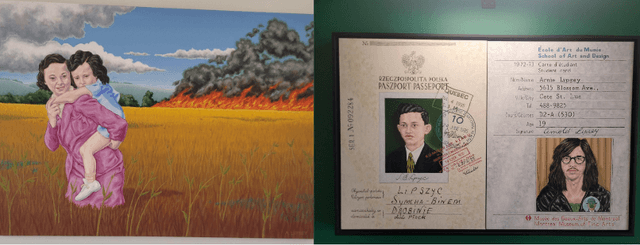Reading Here is Still Here, it’s hard to remember that it’s fictional. The novel by Sivan Slapak follows Isabel, the protagonist, through encounters with her family and friends. The novel jumps back and forth between Isabel’s experiences living in Montreal and Jerusalem. Her time in Jerusalem focuses on her twenties and thirties, while her time in Montreal explores her adulthood beyond that. Isabel, throughout her journey, fearlessly shows her love for her family and for Judaism.
Given the opportunity to interview Slapak, I was curious to ask her about how much of the novel is, in fact, fictitious. Too easily can one assume that Isabel’s life is Slapak’s own, given the piercing humanistic portrayal of Isabel. In an interview with Nu Magazine, She admits that it “is not true” to say that the book has “nothing” to do with her; instead, she explains that though the story “leans very close to [her] own experience,” it is “extremely fictionalized.”
Isabel’s grandmother, a survivor of the Holocaust, is based on Slapak’s own Bubby, Luba. Isabel’s relationship to her grandmother encompasses love, historical curiosity, and pushes Isabel towards her interest in Yiddish culture and language. This is purposeful: Slapak wanted it to be “very clear how much the grandmother was loved.” The book, as Slapak says, is about “international inheritance of Holocaust memory.”
Like many, Isabel’s family followed the “common track” where Holocaust survivors were silent to their own children but poured their stories out to their grandchildren. The novel delves into the often underexplored generational trauma between Holocaust survivors and their families. Through engaging with this narrative, Slapak is spearheading a much awaited turn in modern Jewish literature, as Isabel’s family story is familiar to many.
In the novel, Isabel’s Bubby speaks strictly in transliterated Yiddish. Without this, Slapak says that “a big part of her personality” would be lost. The reader can picture a Bubby-like-figure pushing out guttural Yiddish from a troubled past, adding to the novel’s strong imagery. Similarly, Arabic and Hebrew are often transliterated. This choice has a similar effect, exemplifying Slapak’s expertise on the culture of Jerusalem and helping the reader feel as if they are being transported to Jerusalem with Isabel.
Jerusalem may just be the city in which parts of the story are set, but it feels like a character in its own right. Isabel makes frequent comments appreciating its diversity – both religiously and ethnically. She visits both Rabbis and psychics for advice, befriends Arabs and Jews, and hopes to learn Hebrew and Arabic. Even Isabel’s romantic encounters reflect the wide array of Jerualem’s characters. The turbulence of the city serves as a background to her personal interactions, revealing more about how individuals are impacted than the politics – a refreshing change, to say the least.
The novel ends with Slapak’s Bubby Luba’s authentic testimony of her Holocaust experiences, a testimony to her life. Just as Isabel feels like she pays tribute to her Bubby in her daily life, Slapak’s ending honours her own Bubby as well.
Slapak doesn’t want to apply a message or lesson to this book or to any novel – she wants the reader “to take whatever they want from the book.” Anyone can learn from Isabel’s story, be it about love and relationships, the multiculturalism of Jerusalem, the richness of Yiddish culture, or about the weight of Holocaust ancestry and one’s family.
Isabel’s story, presented through “the people she met and the observations she made along the way,” allows the reader to “interpret them as you wish.” I highly recommend Slapak’s novel; Isabel’s stories will not be forgotten soon, and after reading Here is Still Here, my understanding of Jewish identity has been strongly enriched.
Powered by Froala Editor


-Jl38Fd3fjvmKTcbMkfJgwrBpZhlTXq.png&w=1920&q=75)



